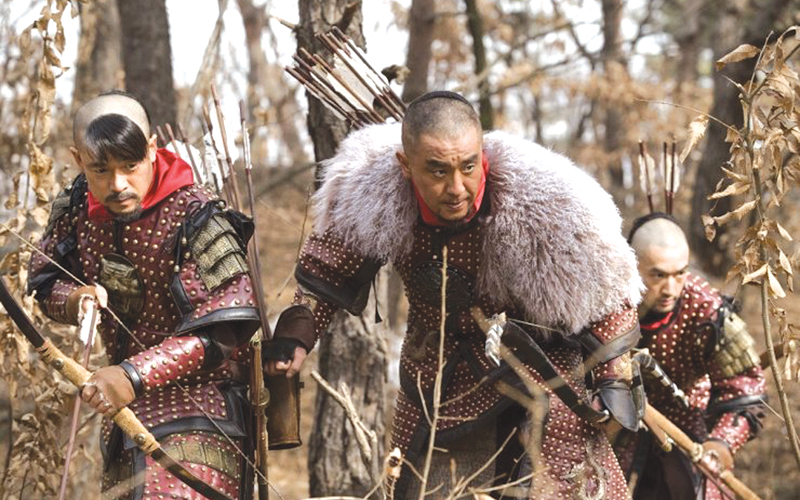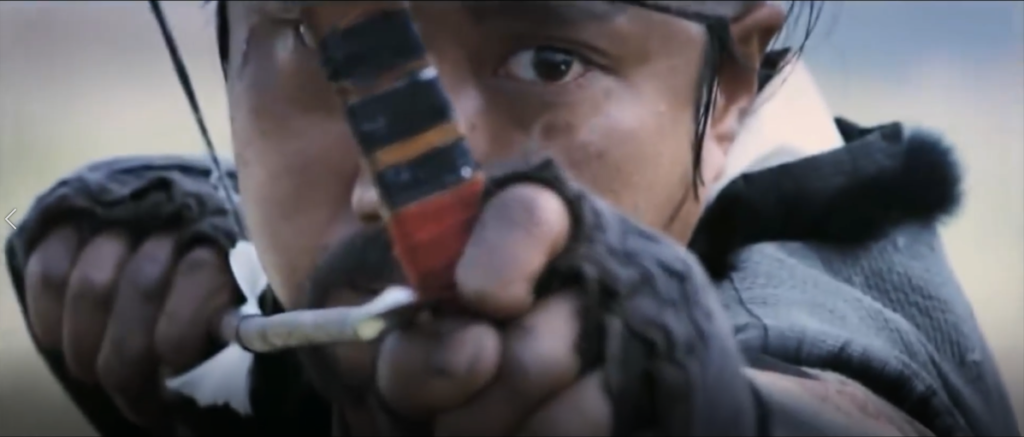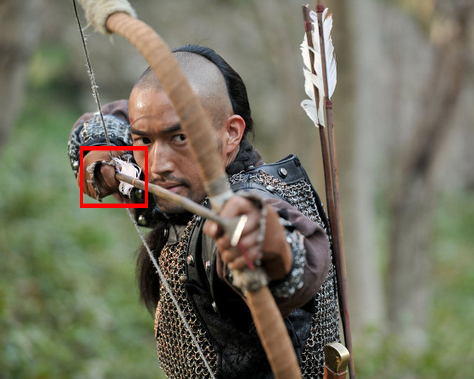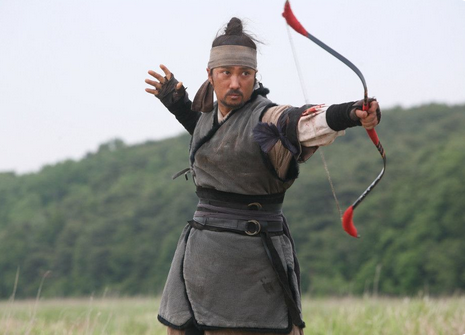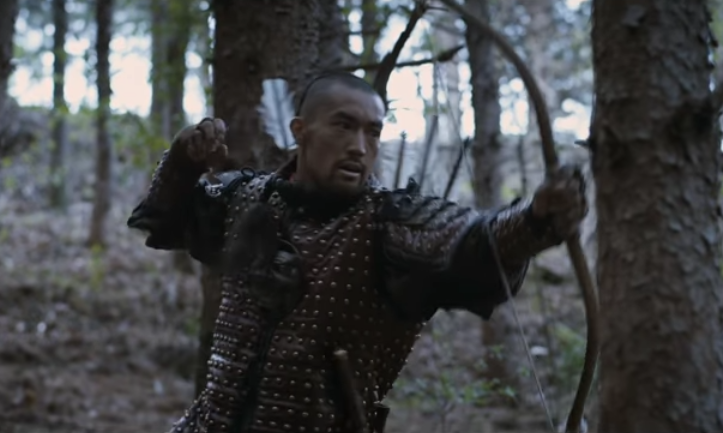Austin Hudgins
Austin Hudgins is a PhD student in the Department of East Asian Studies at Princeton University as well as a traditional archery practitioner
For those interested in Qing era history or Manchu culture, the 2011 South Korean film, Choe jong byeong-gi whal (Kor. 최종병기활), directed by Kim Han-min, is an absolute must. Translated into English as The War of the Arrows, the title literally means, “the final weapon – the bow.” Set at the time of the 1636-1637 Qing invasion of Korea, the movie is not only full of Manchu dialogue, but also (and as the film’s title implies) impressive displays of archery. Listening to the film’s spoken Manchu, it is clear that the producers of The War of the Arrows made a serious attempt to accurately portray early 17th-century Manchu speech. However, did this meticulous attention to detail carry over to the film’s portrayal of toxophily? To what degree do the archery techniques within the film remain faithful to those described in 17th-18th century Manchu archery treatises?
To be sure, the movie does not solely portray Manchu bowmen. In fact, the film’s most fantastic feats of archery are displayed by Arrows protagonist and Joseon loyalist Nam-yi. Interestingly enough, from my observations, Nam-yi’s archery techniques and forms closely resemble those described in Qing-era Manchu archery treatises. This is not too peculiar, considering the proximity of the Manchu homeland to Joseon Korea and China proper, and that all three cultures possess proud archery traditions. Undoubtedly, cross-cultural exchange of archery techniques among these traditions has taken place for centuries. In this post, I examine several scenes of archery within Arrows, and then compare the techniques used in these scenes with those described in two 18th-century Qing archery treatises. The first treatise, a bilingual text dated to 1770 titled The Aim of Archery (Ma. Gabtan i jorin), was written in both Manchu and Chinese by Canggiyūn 常鈞 (?-1789?), of the Yehe Nara lineage, then on duty in newly-conquered Altishahr. The second, older, treatise, Mounted and Dismounted Archery Diagrams 馬步圖像, by Liu Qi 劉奇, is found in his 1722 Illustrated Guide to Archery 繡像射法指南車.
Before we turn to examining the archery scenes in The War of the Arrows, let’s first look at a section of Canggiyūn’s The Aim of Archery, “On the Nocking of Arrows,” which will serve as one of our lenses of analysis:
Niru solbirengge.
Niru solbire de. uli be tuwarakū. beri darame wen turibure be targaci acambi. terei nimeku. gala eshun. uli de nikebume niru gocire arga be bahakū haran.
uli be wen de tebuhe manggi. nergin de uthai teleme cirakan obufi. dulimba simhun ferhe simhun de nikefi. ferhe simhun hūsuwaleme tukiyeme moco simhun hūsutuleme gidame. tereci gūwa ilan simhun fita seferfi. julergi nujan tulesi dedubume. amargi nujan dosi kurbumbi.
beyei kemun be bahaci tetendere. geli dedubume kurbume mutere ohode. ini cisui uli tunggen de nikembi. niru dere de nikembi kai. tere dade julergi nujan i ferhe simhun. moco simhun. urunakū niru i cikten i juwe ergi be. weihuken i hafira oci. niru tuhenere ufaracun de isinarakū ombi.
dekdeni gisun. butalin simhun de nikenjirakū oci. ainaha seme goibure kooli akū. simhun butalin de haminarakū oci. adarame tosome tulbime mutembi sehebi..
On the Nocking of Arrows:When nocking the arrow, do not look at the bowstring. One should guard against drawing the bow taut and letting the arrow’s notch detach [from the string]. This error is the result of untrained hands’ inability to perform the technique of supporting the arrow on the bowstring while drawing [the bow].
After setting the notch onto the bowstring, at that moment, thereupon stretch [the bow] rather taut, and then bend the middle finger over the thumb. Next, press the thumb up [against the middle finger] and press the index finger down [against the thumb]. After that, the other three fingers clench tight [into a fist]. Then, the front-hand cants toward the outside; the back-hand rolls toward the inside.
Provided that one assumes the [proper] bodily posture, and if he can subsequently cant and rotate his hands, naturally the bowstring will touch his chest and the arrow will contact his face! Moreover, surely if one lightly pinches the two sides of the arrow shaft with the front hand’s thumb and index finger, the arrow will not mistakenly fall to the ground.
A common adage states, ‘If the arrowhead clasp does not come to rest on the finger, surely there is no reference point for hitting the mark. If the finger is not near the arrowhead clasp, how can one formulate and estimate [distance and windage]?’ This, indeed, cannot be disputed!”
Canggiyūn, Gabtan-i jorin, pp. 20a-22a.
Although there is much to discuss from this section of Canggiyūn’s treatise, for the purposes of this post, I am principally drawn to three components of his instructions. First is the specific positioning of the fingers in the draw hand. Although subtle, throughout The War of the Arrows, Nam-yi uses techniques similar to those described above, in which his draw hand is clenched and the bowstring hand is rotated clockwise just prior to loosening an arrow that has been drawn all the way to the fingers of the front hand. For an example of what this looks like, see Nam-yi in Figure 1 below:
Figure 1
For those trained exclusively in Western style archery, where the arrow is placed on the inside of the bow, Nam-yi’s placement of the arrow on the outside of the bow may appear backward. However, this is because Nam-yi is using a thumb ring, which, when he releases the arrow, causes it to flex around the bow shaft in a particular way, different from when one uses the Western-style three-finger draw. It is somewhat odd that, although Canggiyūn describes the positioning of the draw hand fingers while the bowstring is gripped in a manner consistent with wearing a thumb ring, he does not mention the use of thumb rings anywhere in his treatise – perhaps because he took for granted that readers would all be using this piece of equipment?
In the above image, we see Nam-yi’s draw hand clenched, with the index and middle fingers pushing down on the thumb, and his thumb pushing up against his index and middle fingers. However, I spotted one scene in the movie where the actor playing a Manchu bannerman is not clenching his draw hand in this manner. In Figure 2 below, notice how the index finger of the draw hand does not push down against the thumb to form a tight fist. Instead, it is wrapped around the arrow’s notch. Shooting in such a manner impairs an archer’s ability to release an arrow cleanly and may negatively affect the arrow’s trajectory towards the intended target.
A second aspect of Nam-yi’s shooting technique that aligns with Canggiyūn’s description is the cant and roll of the hands prior to release. In several scenes within The War of the Arrows, just before Nam-yi loosens an arrow, his front hand cants clockwise and his back hand rolls inward. As shown above, Canggiyūn instructs doing the same thing, for the reason that it allows the string to touch one’s chest and the arrow to touch one’s face. However, Canggiyūn’s treatise does not fully explain the justification for using this technique. To understand the technique’s rationale, one must look to one of Canggiyūn’s sources, Discussions on Shooting (Sheshuo 射說), by the Qing-period author Gu Gao 顧鎬. In the “Nocking an Arrow” chapter of Discussions on Shooting, Gu writes:
既扣箭入弦, 大指与食指紧靠, 食指尖毋出大指甲; 大指用昂力, 食指用压力,其余三指, 不虚不实; 前拳往外卧, 后拳往内滚. 身法既得, 又能卧滚, 自然脖靠肩, 肋靠弦, 箭靠脸矣.
Once one nocks the arrow onto the string, the thumb tightens together with the index finger and presses up against one another, the tip of the index finger does not exceed beyond the thumbnail. The thumb pushes up [against the index finger] and the index finger pushes down [against the thumb]. The remaining three fingers are neither spaced nor crammed. The front fist cants outward, the back fist rolls inward. When one possesses proper body posture, and cants and rolls [the fists], the neck naturally leans against the shoulder, the rib cage rests upon the string, and the arrow touches the face.
Gu Gao, She shuo 射說, in Tang Hao 唐豪, ed., Qingdai sheyi congshu (Taiyuan: Shanxi chuban jituan, 2008), pp. 12-44.
From reading Gu Gao, the apparent reason for the cant and roll is a bit clearer: it positions the archer’s body into a fine-tuned alignment optimal for arrow release. In their translation and restoration of Gao Ying’s 高穎 Ming-era work on methods of archery, Chinese archery experts Jie Tian and Justin Ma indicate that the front shoulder tends to become misaligned and hyper-extended when the rear shoulder and back muscles draw the bow taut.1 Thus, canting helps archers settle the bow arm and shoulder into proper placement.
It must be remembered that standard Manchu and Chinese war bows of the Ming and Qing eras had draw weights that could reach upwards of 120 pounds.2 (For comparison, a 70-lb draw weight for a modern hunting bow is considered quite high.) Consistently using improper form with bows of such high draw weight increases risk of injury to the archer. Presumably, for expert archers like Nam-yi, canting and rolling not only helped them draw heavy bows with correct posture, but also lessened their susceptibility to injury. Regarding The War of the Arrows’ portrayal of Manchu archery, it’s interesting that Nam-yi is the only archer depicted as utilizing this technique. Possibly, this was done purposely on behalf of the film’s producers. In any case, we may imagine that Canggiyūn would have been dismayed at the neglect of this form by the movie’s Manchu archers!
The third and final aspect of archery technique referenced in Gabtan-i jorin has to do with a common adage cited at the end of Canggiyūn’s “Nocking” chapter about the need to draw the arrowhead clasp until it rests on the fingers of the front hand. In traditional archery, there are no sights on the bow to help the archer aim. The archer’s source of aim are his/her instincts, honed through years of practice. As such, prolonged practice by adhering to the same bodily posture and anchor points when drawing the bow is needed. Consistently drawing the arrow until its clasp reaches the front hand’s fingers helps ensure that the arrow leaves the bow with the same force and velocity following each shot. This provides the archer with a constant that better helps him or her assess the needed elevation or windage to hit the target. Moreover, as Canggiyūn indicates, drawing the bowstring up until the arrow clasp allows the archer to use his/her front hand’s index finger and thumb to lightly hold the arrow in place until the arrow is released. A prime example of drawing the arrow until it reaches the front hand’s fingers occurs towards the end of the film when the Manchu captain Jošinta takes aim at Nam-yi. See Figure 3 below:
Figure 3
Canggiyūn’s Aim of Archery is not the only extant 18th century treatise on Manchu archery from which we can judge the authenticity of the techniques used in War of Arrows. There is also Liu Qi’s Mounted and Dismounted Archery Diagrams, which depicts Qing bannermen shooting bows both while standing and from horseback. In the preface to Liu’s work, he asserts that the Capital Guard (京衛), and presumably their style of archery, informed the text’s diagrams and descriptions of archery. Below I provide and translate a page from Mounted and Dismounted Archery Diagrams that was reprinted in Tang Hao’s 唐豪 Collection of Qing Dynasty Art of Archery 清代射藝叢書, titled, “Appearance of the Effective Release Method” 撒手驗法勢.
Appearance of the Effective Release Method:
This picture is suitable for seeing the characteristic that his front hand neither moves nor sways. Thus, this is the touch that brings this whole picture to life, the conclusion’s foremost undertaking. [This is] precisely the meaning of the ancient method which states, “The rear hand releases the arrow, the front hand is unaware.” As for the rear fist extending out level, [this] merely sanctions a centered and upright marvel [of a shot]. If it is too forceful, then there will also be blunder. The two techniques alike are critical, one cannot take them lightly.
Liu Qi, Xiuxiang shefa zhinanche 繡像射法指南車 (1722), in Tang Hao 唐豪, ed., Qingdai sheyi congshu (Taiyuan: Shanxi chuban jituan, 2010), p. 106.
From the above description, one can glean that Liu advocates for a spontaneous release of the bowstring, one where “the rear hand releases the arrow, [and] the front hand is unaware.” This is not to say that there is no coordination between the two hands during the release – quite the contrary. For those who have read Eugene Herrigel’s Zen in the Art of Archery, one of the more memorable moments of the book surrounds Herrigel learning how to release the arrow in a natural, unforced, or spontaneous, manner. Herrigel’s teacher likens the feeling of the moment of release as to when a ripe piece of fruit falls from a tree on its own accord – “It shoots.”3
Interestingly, in the Aim of Archery Canggiyūn likewise alludes to ripe fruit as it relates to the release. In the chapter titled, “Drilling Methods: A Sequence of Essential Directives for Advancing” (urebure arga. ilhi aname ibeme dosire oyonggo kemun), Canggiyūn argues against practicing the release while “empty pulling”4 (untuhun tatambi): drawing the bowstring without an arrow nocked onto it. Apart from the fact that releasing the bowstring without an arrow nocked onto it would damage the structural integrity of the bow, he provides the additional reasoning below:
ainci untuhun tataci. meiren i hūsun be nonggibure teile dabala. uksalame sindame banjinarakū de. uli be fergeleme bargiyame ofi. sube giranggi nememe cirgashūn bime. juwe nujan de. emu hacin i faksi ba tucibume muterakū be dahame. untuhun i tatame fulukan i toktobuha amala. uthai uksalame sindara arame. tacihai goidaha manggi. ini cisui urefi. gabtara nergin de. ureshūn i dorgici faksi ba banjinara de isirakū kai. erei dorgi banjinara giyan be gisurere de mangga. dolori ulhinjeme gaikini.
Presumably, when one engages in ‘empty pulling,’ one only increases one’s shoulder strength . When unable to release, because [one] is clenching and holding the bowstring back with the thumb, [it] causes [one’s] tendons and bones to be especially taut. Because [doing this] does not allow [one] to exercise that sort of skill between the two fists [used to release an arrow], after being excessively conditioned to empty pulling, and following a long period of learning this way, this naturally develops into a habit for releasing. Then, when one is [actually] about to shoot, it inhibits the emergence of the ‘right moment’ [release] that comes about from inside oneself. It is difficult to explain this “coming about from the inside” principle. Let one internally begin to acquire understanding.”
Canggiyūn, Gabtan-i jorin, p. 16b.
In the parallel Chinese script that runs alongside the Manchu in the above passage, Canggiyūn uses the character shu 孰, which has the connotation of ‘to mature or ripen,’ to describe the emergence of this right moment of release. Just as Herrigel struggled to understand his teacher’s fruit metaphor and explanation for the release, Canggiyūn, too, struggles with describing this spontaneous occasion for release that arises from within.
All the more revealing, then, that in Qi’s description and diagram above, rather than focus exclusively on the feeling of spontaneous release, he is adamant that, following release of the bowstring, the archer needs to cast his drawn hand out behind him level with his bow hand. In The War of the Arrows, after Nam-yi and Manchu bowmen shoot arrows, they also cast back their draw hands, but not as Liu advocates. See the two figures below:
In the above figures, we see that Nam-yi and the Manchu bannerman cast back their hands into 60-degree angles following their releases. Pragmatically speaking, the draw hand has a natural tendency to recoil backwards following release of the bowstring and the tension stored within it from being drawn taut. But that is only if the archer’s release is a clean release. One aspect of obtaining a clean release is not letting up on the bowstring during release. A recoiled hand is a sign that the archer maintained proper bowstring tension when it was released. Unclean releases negatively impact the speed and flight of the arrow. According to Liu, the justification for this release technique is that it helps ensure the arrow flies upright, or true, after it has been shot. Ostensibly, Liu’s promotion of casting the draw hand behind and level after the release was a protocol that forced the archer to follow through with a clean and even release. As mentioned above, the key to instinctive archery is consistency. Although casting the draw hand all the way back in the manner advocated by Liu seems a bit dramatic, it here serves as a standard form which through regular training would eventually become ingrained into the archer’s technique, helping to ensure clean releases of the bowstring.
From our analysis of the Aim of Archery and the Mounted and Dismounted Archery Diagrams, I would suggest that The War of the Arrows overall accurately portrays Manchu archery as depicted within these texts, even if, as noted, it was not only the Manchus in the movie who are shown shooting. By some measures, the techniques of the Korean bowman Nam-yi better matched Manchu shooting protocol described in the above two texts than did the movie’s Manchu bannermen. Whether or not this was the intent of the movie’s director or producers, we can say that at a minimum this aspect of the film shows the exchange of archery techniques amongst different cultures during the early 1600s when Qing power was on the rise.
Notes
- Jie Tian and Justin Ma, The Way of Archery: A 1637 Chinese Military Training Manual (Atglen, PA: Schiffer Publishing, 2014), p. 24.
- Wang Zilin 王子林, “Qingdai gongshi,” Gugong bowuyuan yuankan 1994.1 (vol. 63), p. 89.
- Eugene Herrigel, Zen In the Art of Archery (New York: Random House, 1971), pp. 76-77.
- In Jull Eijk and Fresco Sam-Sin’s translation of Gabtan-i jorin, this term is translated as ‘dry pulling.’ See “Targets in Shooting,” in Fresco Sam-Sin, ed., Debtelin:Manchu Archery, no. 2 (February 2018), p. 83.

